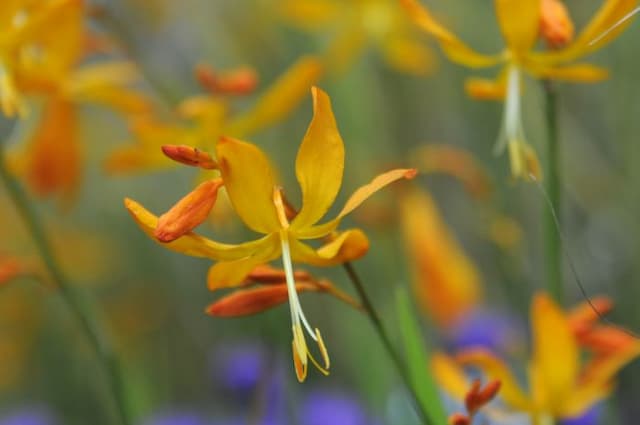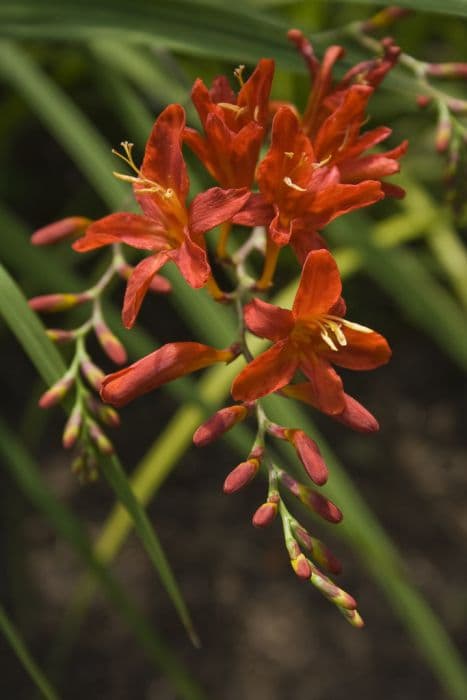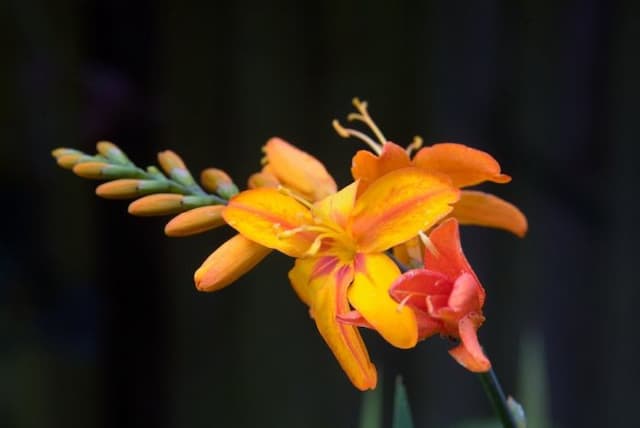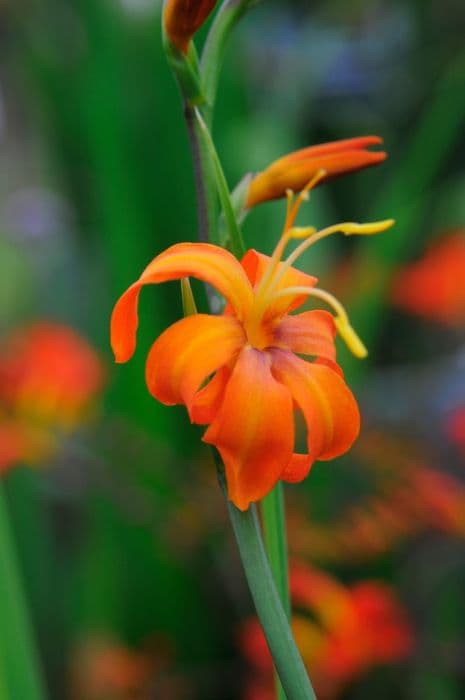Siberian Iris Iris 'Kathleen Mary' (Sib)

ABOUT
Iris 'Kathleen Mary' is a striking plant characterized by its distinctive flowers and foliage. The blooms of this Siberian iris variety are typically a soft lavender color, with falls (the lower petals) that are adorned with striking white and gold markings. The standards (the upright petals) may stand regally above the falls, showcasing the same lavender hue. The blooms are noted for their intricate veining and subtle color variations which can range from lighter shades to deeper purples depending on the individual flower. The foliage of Iris 'Kathleen Mary' is made up of long, slender, sword-like leaves that are a vibrant green. These leaves are often upright and arch gracefully, giving the plant a lush, grassy appearance even when it's not in bloom. The leaves can create a dense clump, providing a background that accentuates the beauty of the flowers. The overall form of the Siberian iris is elegant and balanced, making it an eye-catching addition to any garden where the focus is on the beauty of the individual flowers and foliage rather than the plant's size.
About this plant
 Names
NamesFamily
Iridaceae
Synonyms
Siberian Iris, Kathleen Mary Iris
Common names
Iris sibirica 'Kathleen Mary'
 Toxicity
ToxicityTo humans
Siberian iris, like many other iris species, contains compounds that can be toxic if ingested. The bulb, or rhizome, of Siberian irises contains irisin, irisine, and iridin which can cause gastrointestinal upset such as nausea, vomiting, abdominal pain, and diarrhea. Handling the plant can also cause skin irritation in some individuals due to the presence of these compounds. Therefore, care should be taken to avoid ingestion of any part of the Siberian iris and to wear gloves if you have sensitive skin or known allergies when working with the plant.
To pets
Siberian iris may also be toxic to pets, including cats and dogs, if ingested. The plant contains similar compounds which can cause digestive disturbances such as vomiting, drooling, lethargy, and diarrhea. In rare cases, if a large amount of the rhizome is eaten, more severe symptoms such as abdominal pain or excessive salivation may occur. Generally, pets avoid eating the Siberian iris because of its bitter taste, but pet owners should be cautious and prevent their animals from accessing parts of the plant.
 Characteristics
CharacteristicsLife cycle
Perennials
Foliage type
Deciduous
Color of leaves
Green
Flower color
Varies
Height
2-3 feet (60-90 cm)
Spread
1-2 feet (30-60 cm)
Plant type
Bulb
Hardiness zones
3
Native area
Europe Asia
Benefits
 General Benefits
General Benefits- Aesthetic Appeal: Adds vibrant colors to the garden with its beautiful blue-purple flowers.
- Pollinator Friendly: Attracts bees, butterflies, and other beneficial insects.
- Low Maintenance: Once established, requires minimal care and is relatively drought-tolerant.
- Seasonal Interest: Blooms in late spring to early summer, providing seasonal interest in the garden.
- Cold Hardy: Adapted to survive in colder climates, making it suitable for a variety of landscapes.
- Versatility: Can be planted in borders, beds, and water-side gardens for diverse design uses.
- Propagation: Can be easily divided to propagate new plants and expand garden displays.
 Medical Properties
Medical PropertiesThis plant is not used for medical purposes.
 Air-purifying Qualities
Air-purifying QualitiesThis plant is not specifically known for air purifying qualities.
 Other Uses
Other Uses- Iris 'Kathleen Mary' can be used as a natural dye, where the flowers provide unique and varied hues for fabrics and textiles.
- The robust and fibrous leaves can be woven into baskets or small articles for household use, showcasing the versatility of the plant.
- Rhizomes of the iris can be dried and incorporated into potpourris for a subtle scent, contributing to the indoor fragrance experience.
- The plant's distinctive flowers can be used in floral art or pressed flower crafts, making decorative bookmarks or framed art pieces.
- Iris 'Kathleen Mary' can be planted in rain gardens due to their tolerance for wet conditions and to aid in rainwater management.
- As a companion plant, the iris can help to visually delineate vegetable garden pathways and discourage animals due to its thick growth.
- The sturdy stems can be used as natural supports for climbing plants in the garden, serving a dual purpose of beauty and function.
- These irises can be used to teach botany and hybridization in educational settings, displaying genetic flower variations.
- The flowering of iris 'Kathleen Mary' can signify the optimum time for planting certain vegetable crops, serving as a phenological indicator.
- Used in ecological landscaping, the iris can attract and support local pollinators such as bees and butterflies, contributing to biodiversity.
Interesting Facts
 Feng Shui
Feng ShuiThe Iris is not used in Feng Shui practice.
 Zodiac Sign Compitability
Zodiac Sign CompitabilityThe Iris is not used in astrology practice.
 Plant Symbolism
Plant Symbolism- Royalty: The Iris carries a regal presence, evoking a sense of royalty and nobility, often associated with its namesake, the Greek goddess Iris who was a messenger for the gods and the personification of the rainbow.
- Hope: It symbolizes hope, a common thread throughout many cultures where the flower is used to inspire people to continue pushing forward.
- Trust: With its upright stance and strong lines, the Iris can represent trust and reliability, suggesting a sturdy allegiance or faithfulness in relationships.
- Wisdom: Historically revered by ancient societies, the Iris is often tied to wisdom, both worldly and spiritual, sometimes used in connection with royalty and divine messengers.
- Valor: The flower has been a symbol of valor and bravery, especially in the context of heraldry and ancient warrior symbols, where it is also known as the fleur-de-lis.
- Purity: Due to its brightness and clean lines, the Iris is also associated with purity, innocence, and chastity, often present in religious ceremonies and rites of passage.
 Water
WaterThe Siberian Iris 'Kathleen Mary' should be watered deeply to ensure moisture reaches the roots, approximately once a week, accounting for rain. During the growing season and especially when the iris is establishing, maintaining consistent moisture is important; however, avoid overwatering as this can cause root rot. Generally, use about 1 gallon of water per plant each week, adjusting for weather conditions, with less water needed during cooler, rainy periods and a potential increase during intense heat or drought.
 Light
LightSiberian Iris 'Kathleen Mary' thrives in full sun to partial shade. The ideal spot for this plant would receive at least six hours of direct sunlight each day, but it can still perform well with some afternoon shade, particularly in very hot climates, which helps prevent the flowers from fading too quickly.
 Temperature
TemperatureSiberian Iris 'Kathleen Mary' is hardy and can tolerate a wide range of temperatures. It can survive winter cold down to about -30 degrees Fahrenheit and summer heat up to 90 degrees Fahrenheit. Ideal growth temperatures fall between 50 and 75 degrees Fahrenheit to promote healthy foliage and vibrant blooms.
 Pruning
PruningSiberian Iris 'Kathleen Mary' should be pruned to remove spent flower stalks after blooming to encourage a tidy appearance and help prevent disease. In late fall or early spring, remove any dead or damaged foliage to promote healthy new growth. Pruning is generally only required once a year, after the flowering period.
 Cleaning
CleaningAs needed
 Soil
SoilThe Siberian Iris 'Kathleen Mary' prefers a well-drained, evenly moist soil mix with high organic matter content. A blend of loamy garden soil, peat moss, and compost works best. The ideal soil pH should be slightly acidic to neutral, ranging from 6.0 to 7.0.
 Repotting
RepottingSiberian Iris 'Kathleen Mary' typically does not require frequent repotting and should be divided and repotted every 3 to 5 years to maintain vigor and flower production.
 Humidity & Misting
Humidity & MistingSiberian Iris 'Kathleen Mary' tolerates a wide range of humidity levels but prefers conditions that are not excessively dry. Average humidity levels similar to those found outdoors are adequate.
 Suitable locations
Suitable locationsIndoor
Provide bright light, cool temperatures, and ensure good airflow for indoor growth.
Outdoor
Plant in full sun to partial shade, in well-drained moist soil.
Hardiness zone
3-9 USDA
 Life cycle
Life cycleIris 'Kathleen Mary', commonly referred to as the Siberian Iris, begins its life cycle when the seed germinates, usually requiring a period of cold stratification to break dormancy. After germination, the plant produces roots and a rosette of narrow, grass-like leaves, entering a vegetative growth phase. As the Siberian Iris matures, usually by the second or third year, it develops a sturdy stem that will bear the distinct irises, typically blooming in late spring to early summer. After the flowering period, the plant sets seed in a capsule that eventually dries and opens to disperse the seeds for reproduction. Throughout the growing season, the Siberian Iris's foliage remains attractive, and as a perennial, the plant will die back to the ground in the winter, only to regrow from its rhizome the following spring. Properly cared for, the Siberian Iris can continue to thrive and go through its life cycle for several years, often requiring division every few years to maintain vigor.
 Propogation
PropogationPropogation time
Late summer
The most popular way to propagate the Siberian Iris 'Kathleen Mary' is through division. This is best done in the late summer after the blooming period has ended, usually from July to September. To divide the plant, carefully dig up the clump of rhizomes, ensuring that you keep a good portion of roots attached to each section. Using a sharp knife, divide the clump into smaller sections, each with at least one fan of leaves and a healthy segment of rhizome. Trim the leaves to about a third of their height to reduce water loss and replant the divisions promptly, spacing them around 18 to 24 inches (approximately 45 to 60 centimeters) apart, at the same soil depth they were growing before. Water the transplants well to help establish them. This method helps maintain the health of the mother plant and also increases the quantity of your Siberian Irises over time.


![Montbretia [Bright Eyes]](/_next/image?url=https%3A%2F%2Fplants-admin.emdemapps.com%2Fimages%2Fplants%2F%2Fimages%2F604b5f4a483b6.png&w=640&q=75)






